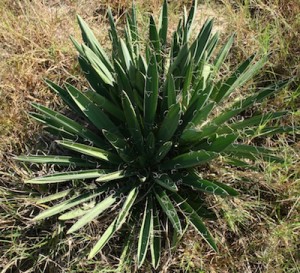Common Yucca – May 2015 Wildflower of the Month
 Distinctive with leathery, evergreen leaves in a dense rosette, this plant looks like its desert relatives. On edges of the stiff, sharply pointed leaves are fraying, twisted whitish threads, which are not usually found on other species of Yucca. During the growing season each plant will produce a spreading cluster of drooping cream-colored flowers on a 6-foot smooth stalk, followed by an oblong, pickle-like fruit. Blooms April-June.
Distinctive with leathery, evergreen leaves in a dense rosette, this plant looks like its desert relatives. On edges of the stiff, sharply pointed leaves are fraying, twisted whitish threads, which are not usually found on other species of Yucca. During the growing season each plant will produce a spreading cluster of drooping cream-colored flowers on a 6-foot smooth stalk, followed by an oblong, pickle-like fruit. Blooms April-June.
Native to eastern and central U.S. and nearly every county in Virginia, this is a plant of dry, sandy soils and sand dunes. While tolerant of salt spray, it does not do well in poorly drained or wet sites, and will not bloom in full shade. After flowering, the fruiting stalk becomes unsightly, persisting for 2-3 years unless pruned away. The very deep tap roots are very difficult to remove, and serve as a method of propagation; many miniature plants will return from broken root segments.
Yucca fruit can be cooked and eaten after the seeds are removed; the large petals are used in salads. Yuccas depend on the Yucca Moth as their agent of pollination, and conversely, the moth larvae depend on yuccas for food.
By Helen Hamilton, past-president of the John Clayton Chapter, VNPS
Photo: Common Yucca (Yucca filamentosa) taken by Helen Hamilton
